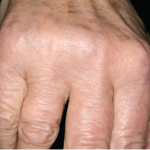Research has demonstrated that exercise-based physical therapy is as effective at maintaining knee function as surgery in patients with degenerative meniscal tears at risk of developing knee osteoarthritis.


Research has demonstrated that exercise-based physical therapy is as effective at maintaining knee function as surgery in patients with degenerative meniscal tears at risk of developing knee osteoarthritis.

In late December, the FDA approved subcutaneous abaloparatide for the treatment of men with osteoporosis at a high risk of fracture. This approval is based on a placebo-controlled study that showed abaloparatide led to significant increases in bone mineral density of the lumbar spine, total hip and femoral neck. Abaloparatide was approved in April 2017 for the treatment of postmenopausal women with osteoporosis at high risk for fracture.

A study from Amigues et al. found that bisphosphonate-associated osteonecrosis of the jaw is rare in patients with osteoporosis and may occur more often in patients treated with injectable zoledronic acid than in those treated with the oral bisphosphonates.

PHILADELPHIA—At ACR Convergence 2022, the much-anticipated ACR Review Course featured talks from eight experts. Topics reflected the heterogeneity of our field and included Sjögren’s disease, spondyloarthritis (SpA), osteoarthritis (OA), paraneoplastic rheumatic syndromes, metabolic bone disease, statin myopathy, Raynaud’s phenomenon and autoinflammatory syndrome. Here, I share highlights from this comprehensive, six-hour session. Sjögren’s Disease Sara S….

Research from Gloersen et al. suggests the systemic effects of obesity, as measured by leptin, may play a role in the severity of pain experienced by patients with hand osteoarthritis.

ATLANTA—The ACR released a summary of its updated guideline for the Prevention and Treatment of Glucocorticoid-Induced Osteoporosis in September. Many patients take glucocorticoids for a variety of inflammatory conditions, and anyone who is taking glucocorticoid medications and has other risk factors for osteoporosis increases their risk of developing glucocorticoid-induced osteoporosis. New osteoporosis medications and new…

A study from Haibel et al. in patients with chronic knee arthritis found intra-articular morphine did not lead to a significant, short-term reduction in pain compared with placebo and proved inferior to treatment with intra-articular triamcinolone.
Background & Objectives Worldwide, osteoarthritis (OA) is a highly prevalent, chronic joint disease that causes pain, disability and loss of function. Global trends demonstrated an increase of more than 100% in years lived with disability due to OA from 1990 to 2019. However, no nonsurgical intervention exists to prevent, halt or even delay OA progression….

Using three complicated patient cases, Kenneth G. Saag, MD, MSc, shared his expertise on osteoporosis and walked through his thought process and the literature, during a session of the 2022 ACR Education Exchange.

Eaton et al. set out to describe the prevalence, incidence and progression of radiographic and symptomatic hand osteoarthritis (OA), and to evaluate differences according to age, sex, race and other risk factors.